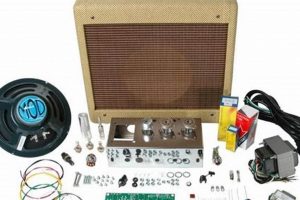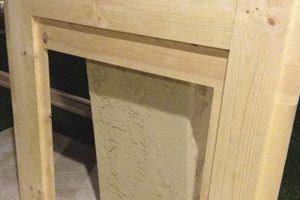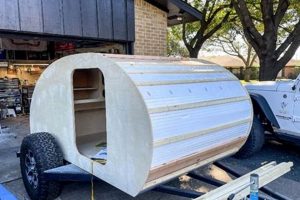A do-it-yourself approach to establishing vegetation utilizing a slurry mixture of seed, mulch, fertilizer, and other additives is gaining traction. This method offers an alternative to traditional seeding or sodding, particularly for homeowners and small-scale landscapers seeking cost-effective solutions for lawn establishment and erosion control. The necessary components are often pre-packaged or available individually, allowing for customization based on specific project requirements.
Employing this technique can provide benefits such as improved seed germination due to the protective and moisture-retaining properties of the mulch. It can also be a faster and less labor-intensive option compared to hand-seeding large areas. The historical context involves adapting commercial hydroseeding practices for smaller applications, making the technology accessible to a broader audience. This adaptation streamlines the process and reduces the equipment investment required.
The following sections will delve into the specific components, application techniques, and considerations for successfully implementing this method. Furthermore, it will explore common issues, troubleshooting tips, and maintenance recommendations to ensure optimal results in various environmental conditions and project scopes.
DIY Hydroseeding Kit
Effective utilization of a do-it-yourself slurry seeding package necessitates careful planning and execution. Adherence to the following guidelines can significantly enhance project success and optimize desired outcomes.
Tip 1: Soil Preparation is Paramount: Before application, conduct a soil test to determine pH levels and nutrient deficiencies. Amend the soil as needed with lime or fertilizer based on the test results. Rake and level the area to create a smooth seedbed, removing any debris or rocks that may impede seed germination.
Tip 2: Seed Selection Matters: Choose a seed mix appropriate for the local climate, soil type, and intended use. Consider factors such as sun exposure, traffic levels, and desired aesthetics when selecting seed varieties. Blends often provide enhanced resilience and adaptability compared to single-species options.
Tip 3: Mulch Application Rate: Follow the manufacturers recommendations for the mulch application rate. Applying too much mulch can inhibit seed germination by blocking sunlight, while insufficient mulch may result in inadequate moisture retention and erosion control.
Tip 4: Water Management is Critical: Consistent and adequate watering is essential, especially during the initial germination phase. Keep the seedbed consistently moist but not saturated. Adjust watering frequency based on weather conditions and soil drainage.
Tip 5: Even Distribution is Key: Ensure uniform distribution of the slurry mixture across the target area. Overlapping or missed spots can lead to uneven growth and patchy coverage. Maintain a consistent spray pattern and nozzle height throughout the application process.
Tip 6: Fertilization Strategy: Incorporate a starter fertilizer into the slurry mix to provide essential nutrients for early seedling development. Select a fertilizer with a balanced NPK ratio appropriate for establishing new lawns or vegetation.
Tip 7: Post-Application Protection: Protect the seeded area from excessive foot traffic, animal disturbance, and heavy rainfall. Consider using netting or erosion control blankets to stabilize the soil and prevent seed displacement, particularly on slopes.
Implementing these strategies will increase the likelihood of successful vegetation establishment, resulting in a healthy and aesthetically pleasing outcome. Proper preparation, careful execution, and diligent maintenance are fundamental to achieving optimal results.
The subsequent sections will provide detailed instructions for troubleshooting common problems and maintaining the newly established vegetation.
1. Component Selection
Selecting the appropriate components is paramount to the success of any do-it-yourself slurry seeding project. The quality and suitability of the seed, mulch, fertilizer, and other additives directly influence germination rates, plant health, and long-term vegetation establishment.
- Seed Variety
The selection of seed varieties should align with the local climate, soil type, and intended use. For example, a shade-tolerant grass seed would be suitable for areas with limited sunlight, while a drought-resistant variety would be preferable in arid regions. Utilizing an inappropriate seed mix can result in poor germination, stunted growth, and susceptibility to disease, ultimately negating the benefits of the slurry seeding method.
- Mulch Type
Mulch serves to retain moisture, protect seeds from erosion, and regulate soil temperature. Different mulch types, such as wood fiber, paper fiber, or straw, offer varying levels of performance in these areas. Wood fiber mulch provides superior erosion control but may be more expensive. Paper fiber mulch is a cost-effective option but offers less protection. Straw mulch can be effective but may introduce weed seeds. The choice depends on the specific needs of the project and the environmental conditions.
- Fertilizer Composition
A balanced fertilizer is essential for providing the necessary nutrients for seedling development. A starter fertilizer, typically high in phosphorus, promotes root growth. The appropriate NPK (nitrogen, phosphorus, potassium) ratio will vary depending on the soil composition and the nutrient requirements of the selected seed varieties. Soil testing is recommended to determine existing nutrient deficiencies and guide fertilizer selection.
- Additives
Various additives can enhance the performance of a do-it-yourself slurry seeding mix. Tackifiers improve mulch adhesion, reducing erosion on slopes. Hydrogels increase water retention, particularly beneficial in dry climates. Dyes can provide visual confirmation of uniform application. These additives can address specific challenges and optimize results, but their necessity depends on the unique circumstances of each project.
The careful consideration and selection of each component is vital for realizing the full potential of a do-it-yourself slurry seeding endeavor. Compromising on quality or selecting inappropriate materials can undermine the entire process, leading to wasted time, effort, and resources. Aligning component choices with the project’s specific needs and environmental conditions is the foundation for successful vegetation establishment.
2. Application Technique
The efficacy of a do-it-yourself slurry seeding process is heavily contingent on the application technique employed. Proper execution ensures uniform distribution of the slurry mixture, maximizing se
ed-to-soil contact and promoting optimal germination rates. Inadequate application can lead to patchy growth, wasted materials, and ultimately, project failure.
- Equipment Calibration and Operation
Slurry seeding kits typically include a specialized sprayer or hydroseeder attachment. Accurate calibration of the equipment is essential for delivering the correct application rate. Operating the equipment requires maintaining a consistent speed and spray pattern to avoid over or under-application in specific areas. Prior practice on a small, non-critical area is recommended to develop proficiency and ensure proper equipment function.
- Mixing Consistency and Slurry Viscosity
The consistency of the slurry mixture directly impacts its flowability and sprayability. Adhering to the manufacturer’s recommended mixing ratios is crucial for achieving the desired viscosity. Insufficient mixing can result in clumping and nozzle clogging, while excessive thinning can reduce the effectiveness of the mulch and fertilizer components. Regular agitation of the mixture during application is necessary to maintain a uniform suspension of solids.
- Environmental Considerations During Application
Weather conditions can significantly influence the outcome of a slurry seeding project. Avoid application during periods of high wind, which can disrupt the spray pattern and lead to uneven coverage. Excessive heat can accelerate evaporation, reducing moisture availability for germination. Ideally, application should occur on a calm day with moderate temperatures. Pre-wetting the soil prior to application can improve moisture retention and seed-to-soil contact.
- Post-Application Irrigation Practices
Proper irrigation following application is vital for promoting germination and seedling establishment. The seeded area should be kept consistently moist, but not saturated, for several weeks after application. Frequent, light watering is generally more effective than infrequent, heavy watering. Monitor soil moisture levels regularly and adjust irrigation schedules accordingly. Avoid creating puddles or runoff, which can dislodge seeds and erode the mulch layer.
In conclusion, a thorough understanding of the application process, coupled with meticulous attention to detail, is crucial for achieving successful vegetation establishment using a do-it-yourself slurry seeding kit. By adhering to best practices and adapting techniques to specific environmental conditions, users can maximize the benefits of this method and create healthy, vibrant landscapes.
3. Post-application Care
Following the implementation of a do-it-yourself slurry seeding process, diligent post-application care is critical for maximizing the success rate of vegetation establishment. Neglecting these measures can compromise the initial investment of time and resources, leading to unsatisfactory results or complete project failure.
- Consistent Irrigation Management
Maintaining adequate soil moisture is paramount during the germination and early growth phases. Irrigation schedules should be tailored to local climate conditions and soil types, with frequent monitoring to prevent both overwatering and underwatering. Insufficient moisture can result in seed desiccation and stunted growth, while excessive moisture can promote fungal diseases and seed rot. A well-calibrated irrigation system or careful hand-watering is essential.
- Nutrient Supplementation Strategies
Newly established seedlings require a consistent supply of essential nutrients to support healthy development. Implementing a post-application fertilization program, based on soil testing and plant needs, ensures optimal growth. Slow-release fertilizers or liquid feed applications can provide a steady supply of nutrients without risking fertilizer burn. Micronutrient deficiencies should be addressed promptly to prevent stunted growth or discoloration.
- Weed Control Implementation
Weed competition can significantly impede the growth of desirable vegetation. Implementing a proactive weed control strategy is crucial for minimizing competition for resources such as sunlight, water, and nutrients. Manual removal of weeds, pre-emergent herbicide applications, or selective post-emergent herbicide applications can be employed, depending on the specific weed species and the stage of vegetation establishment. Care should be taken to avoid damaging the newly established seedlings.
- Erosion Mitigation Protocols
Newly seeded areas, particularly on slopes, are susceptible to erosion from rainfall and wind. Implementing erosion control measures is essential for preventing seed displacement and soil loss. Erosion control blankets, straw wattles, or jute netting can provide physical protection against erosion. Maintaining adequate ground cover through prompt vegetation establishment is the most effective long-term erosion control strategy.
Effective post-application care is not merely an optional addendum to a do-it-yourself slurry seeding project; it is an integral component that directly influences the long-term viability and aesthetic appeal of the established vegetation. A proactive and diligent approach to irrigation, fertilization, weed control, and erosion mitigation is essential for realizing the full potential of this technique.
4. Equipment Maintenance
The operational longevity and effectiveness of a do-it-yourself slurry seeding setup are intrinsically linked to consistent and thorough equipment maintenance. Neglecting routine maintenance protocols can lead to reduced performance, premature equipment failure, and ultimately, suboptimal vegetation establishment. The following aspects delineate the crucial connection between equipment upkeep and successful project outcomes.
- Nozzle Cleaning and Inspection
The nozzle is the critical point of dispersion for the slurry mixture. Clogging or damage to the nozzle directly affects the uniformity of application and the overall efficiency of the process. Regular cleaning after each use, coupled with periodic inspection for wear or damage, ensures consistent spray patterns and prevents uneven seed distribution. Replacement of worn nozzles is essential to maintain optimal performance.
- Pump Maintenance and Lubrication
The pump is responsible for generating the pressure required to propel the slurry mixture through the nozzle. Regular inspection of the pump for leaks, cracks, or other damage is necessary. Lubrication of moving parts, as specified by the manufacturer, reduces friction and extends the pump’s lifespan. Neglecting pump maintenance can lead to reduced pressure, inconsistent flow rates, and eventual pump failure.
- Hose Inspection and Repair
The hose serves as the conduit for the slurry mixture from the tank to the nozzle. Cracks, kinks, or leaks in the hose can reduce pressure, cause uneven application, and result in wasted materials. Regular inspection for damage and prompt repair or replacement of damaged sections is essential for maintaining consistent flow and preventing costly leaks.
- Tank Cleaning and Storage
Residue buildup within the tank can lead to clogging of the pump and noz
zle, as well as contamination of subsequent slurry mixtures. Thorough cleaning of the tank after each use prevents residue buildup and ensures optimal performance. Proper storage of the equipment in a dry, protected environment prevents corrosion and extends its lifespan.
In summary, meticulous equipment maintenance is an indispensable component of a successful do-it-yourself slurry seeding endeavor. By adhering to recommended maintenance protocols, users can maximize the lifespan of their equipment, ensure consistent performance, and achieve optimal vegetation establishment results. The time and effort invested in routine maintenance translates directly into improved project outcomes and reduced long-term costs.
5. Environmental Factors
Environmental conditions exert a profound influence on the success of any vegetation establishment endeavor, and do-it-yourself slurry seeding is no exception. Understanding and accommodating these factors is crucial for achieving optimal germination rates, plant health, and long-term sustainability.
- Climate and Temperature
The prevailing climate dictates the suitability of specific plant species and influences the timing of the slurry seeding application. Temperature directly affects seed germination rates and seedling growth. Extreme temperatures, both high and low, can inhibit germination or damage young plants. Selecting appropriate plant species for the local climate and applying the slurry mix during optimal temperature windows are essential considerations.
- Soil Composition and pH
Soil type and pH levels significantly impact nutrient availability and root development. Different plant species have varying soil preferences. Acidic or alkaline soil conditions can inhibit nutrient uptake and hinder plant growth. Conducting a soil test to determine pH and nutrient levels is crucial for selecting appropriate plant species and amending the soil accordingly. Altering the pH with lime or sulfur may be necessary to create optimal growing conditions.
- Sunlight Exposure and Shading
The amount of sunlight exposure influences plant growth and development. Some plant species thrive in full sun, while others prefer partial or full shade. Understanding the sunlight requirements of the selected plant species is essential for ensuring optimal growth. Planting in areas with insufficient sunlight can lead to stunted growth or failure to thrive. Consider existing shading from trees or buildings when selecting planting locations.
- Water Availability and Drainage
Adequate water availability is crucial for seed germination and seedling establishment. Poor drainage can lead to waterlogged soil, root rot, and plant death. Conversely, insufficient water can cause seed desiccation and stunted growth. Assessing the soil’s drainage characteristics and implementing appropriate irrigation practices are essential. Amending the soil with organic matter can improve drainage and water retention.
By meticulously assessing and addressing these environmental factors, practitioners can significantly enhance the success of their do-it-yourself slurry seeding projects. Tailoring plant species selection, soil preparation, and management practices to the specific environmental conditions will promote vigorous growth, long-term sustainability, and the realization of the project’s intended goals.
Frequently Asked Questions
This section addresses common inquiries regarding the use of do-it-yourself slurry seeding packages. The information presented aims to clarify misconceptions and provide guidance for optimal application and results.
Question 1: Are specialized tools required for effective implementation?
While some kits include specialized sprayers, alternatives such as garden sprayers or pump sprayers can be utilized with careful attention to slurry consistency and application rate. The choice of equipment depends on the project scale and desired precision.
Question 2: What is the expected longevity of results compared to traditional sodding?
With proper soil preparation, maintenance, and environmental conditions, vegetation established through this method can exhibit comparable longevity to sodding. However, the initial establishment phase may require more diligent monitoring and care.
Question 3: How does the cost-effectiveness compare to professional hydroseeding services?
Do-it-yourself kits generally offer a more economical solution for smaller areas. However, professional services may be more cost-effective for larger properties or projects requiring specialized expertise and equipment.
Question 4: What factors influence the optimal time of year for application?
The ideal application window depends on the specific plant species and local climate. Generally, spring and fall provide favorable conditions for germination and seedling establishment, avoiding extreme temperatures and water stress.
Question 5: Are there specific soil types that are unsuitable for this method?
Extremely compacted or poorly drained soils may require amendment prior to application. Conducting a soil test and addressing any deficiencies or drainage issues is crucial for maximizing success.
Question 6: What measures should be taken to prevent weed encroachment during the establishment phase?
Pre-emergent herbicides can be applied prior to seeding to prevent weed germination. Post-emergent herbicides can be used selectively to control existing weeds without harming the newly established vegetation. Hand-weeding may also be necessary in certain situations.
In summary, employing a do-it-yourself slurry seeding package effectively involves careful planning, appropriate component selection, diligent application, and consistent post-application care. Understanding these aspects is key to achieving successful vegetation establishment.
The subsequent section will provide a comparative analysis of available products and kits, offering guidance for selecting the most suitable option based on project-specific requirements.
DIY Hydroseeding Kit
The preceding discussion has explored the multifaceted aspects of employing a do-it-yourself approach to slurry seeding. From meticulous component selection and precise application techniques to diligent post-application care and equipment maintenance, success hinges upon a comprehensive understanding of the process. Furthermore, the critical influence of environmental factors cannot be overstated, demanding careful assessment and adaptation to specific site conditions.
Ultimately, the informed and conscientious utilization of a diy hydroseeding kit presents a viable method for establishing vegetation, offering an accessible alternative to professional services for smaller-scale projects. Continued adherence to best practices and a commitment to ongoing learning will yield the most favorable and sustainable results. Prioritize thorough research, and proper execution to achieve optimal vegetation establishment and lasting landscape enhancement.







